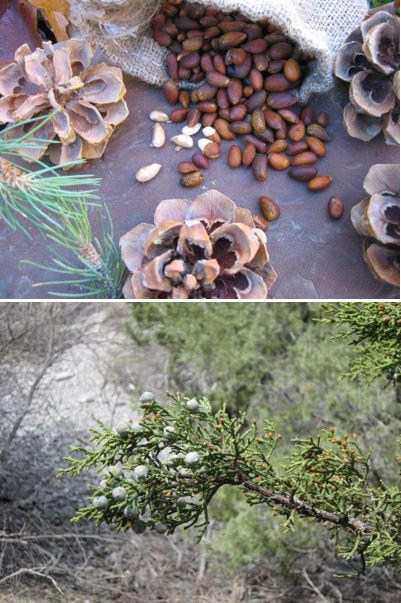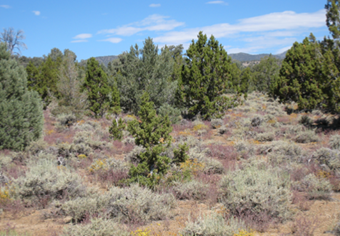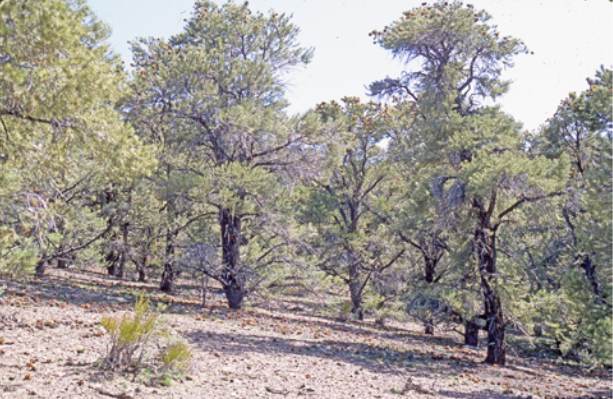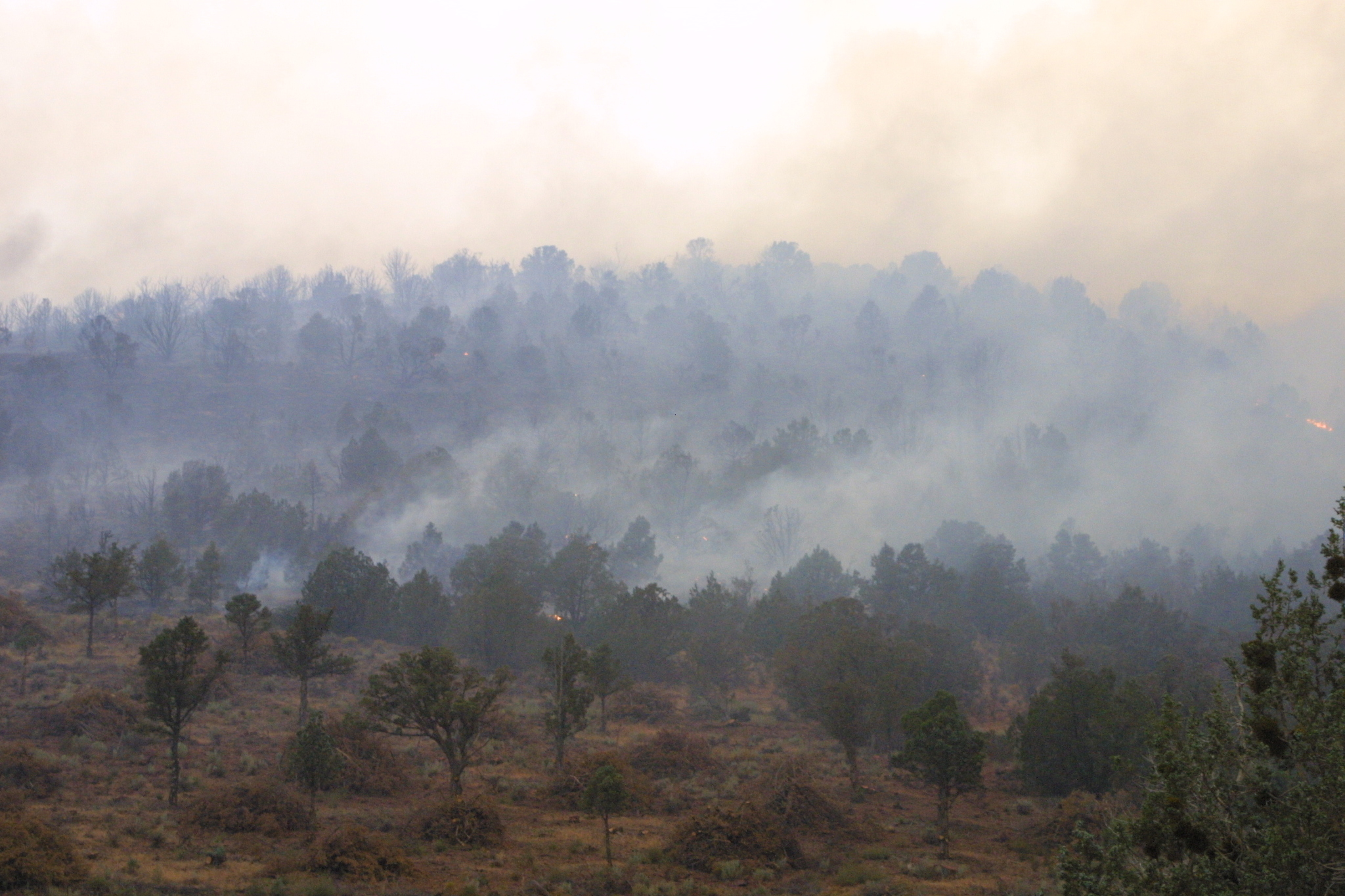042 - Pinyon-Juniper Ecology and Management
Pinyon-Juniper Ecology

The forest type covering the most land in Utah is pinyon-juniper (PJ), which generally occurs in the foothills at elevations of 5,000 to 8,000 feet. These woodlands make up 60% of Utah’s forest cover, covering 8 million acres of land in Utah alone. Two varieties of pinyon can be found in Utah, singleleaf (Pinus monophylla) and Colorado (P. edulis), and two types of tree-sized junipers, Utah (Juniperus osteosperma) and Rocky Mountain (J. scopulorum). These species have adapted to withstand severe drought and cold and can commonly be found growing on harsh sites.
Stand structure and composition are influenced by elevation, climate, disturbance regime, and growing conditions. In the foothills, PJ often grows in grasslands or shrublands. As elevation increases, they grow with other tree species such as mountain-mahogany (Cercocarpus species), ponderosa pine, white fir, or Douglas-fir.

Their use is limited due to their growth habit and formation, yet there are still benefits within PJ woodlands. Juniper’s resistance to decay makes it an ideal species for posts and poles. It also makes good firewood. Pinyon can be used for firewood or processed into pellets. Both pinyon and juniper are valuable wildlife species, providing habitat and winter food (pine nuts and juniper berries). The pine nuts of the pinyon are also highly valued and sought after.
Pinyon-Juniper Expansion
Since the mid-1800s, PJ woodlands have been expanding into sagebrush-steppe shrublands and grasslands. Current estimates are that they now comprise 40% of the total forest and woodland area of the Intermountain West and are expanding at a rate of about 0.5% per year, 20% of which is represented by expansion into non-forest and 80% infill within areas already colonized by PJ (Filippelli et al., 2020). PJ expansion occurs in three phases—phase I, phase II, and phase III. Regarding the structure of plant communities, phase I is open-canopy, scattered PJ with sagebrush, and perennial grasses dominating. Phase II occurs as PJ density increases, thereby thinning the sagebrush understory and PJ becoming co-dominant. Phase III is characterized by complete PJ dominance and little to no sagebrush understory. In Utah, there is a preponderance of PJ transitioning from phase II to III due to the even-age nature of many stands and ongoing expansion.

Phase I of PJ expansion.

Phase II of PJ expansion.

Phase III of PJ expansion. Photos courtesy U.S. Geological Survey.
Moisture availability and temperature greatly influence the expansion and decline of PJ woodlands. Wetter conditions, combined with the open canopy structure commonly found in PJ woodlands (phase I), provide suitable conditions for pinyon and juniper seedlings to become established (phase II), resulting in PJ-dominated stands (phase III). When followed by periods of drought, the dense stands provide a fuels hazard and can result in large stand-replacing fires. When phase III burns, it is hard to control, is dangerous to firefighters, and can scorch soils. High-intensity fires make it difficult for native habitat to regenerate but can provide ideal conditions for invasive species such as cheatgrass to take over. This replacement alters the ecosystem drastically, negatively impacting wildlife and seriously threatening human development.

With climate change, livestock grazing, and fire suppression (among other factors), PJ is quickly expanding on sites where it has not previously been found, threatening other valuable habitats, such as that of the sage-grouse, as well as human habitat. Much of the PJ woodlands in Utah are found in areas where urban communities meet wildlands, known as the wildland urban interface (WUI). As the WUI continues to grow and human development continues to encroach on wildland areas, proper management of these expanding woodlands is vital. Grazing increases PJ density because cows prefer the grass, not the wood, so over time, the wood takes over because cows eat all the competition. Fire suppression and lack of management have also caused PJ density to increase over the past century, resulting in stands that support crown fires, burn intensely, and threaten the WUI.
Pinyon-Juniper Management

Combining management practices such as thinning and prescribed burning can provide many long-term benefits. Thinning to reduce stand density improves individual trees’ health and vigor by decreasing the amount of competition for valuable resources while also reducing the risk of tree mortality due to insects and diseases, including the bark beetle pinyon ips. Thinning also allows for a healthy balance between overstory trees, young trees, and other vegetation types. After a thinning treatment, prescribed fire use can reduce the hazardous fuels, stimulate understory growth, and increase diversity. The decrease in density and fuels reduces the chance of high-severity fires, thereby mitigating wildfire risk. It should be noted, however, that thinning is not a silver bullet and may be more appropriate in less dense woodlands or at small sites near a water source, where understory restoration may be more successful.
Not all PJ stands are a result of recent expansion. Many places in Utah feature very old, twisted, and gnarled pinyon and juniper trees, full of character, considered persistent on the landscape and not a result of the recent changes discussed here around expansion. Romme et al. (2008) point to persistent juniper, PJ savanna, and wooded shrublands as important ecological groupings. It is worth protecting these stands from treatments.
All photos courtesy of Darren McAvoy unless otherwise noted.
A special thank you to our funding partner representative, Colby Peterson, for his comments and assistance and to Mark Brunson, Ph.D., for sharing his expertise and feedback.
Resources
- Coates, P.S., Prochazka, B.G., Ricca, M.A., Gustafson B.K., Ziegler, P., & Casazza, M.L. (2017). Pinyon and juniper encroachment into sagebrush ecosystems impacts distribution and survival of greater sage-grouse. Rangeland Ecology and Management, 70(1), 35–38.
- Filippelli, S. K., Falkowski, M. J., Hudak, A. T., Fekety, P. A., Vogeler, J. C., Khalyani, A. H., Rau, B.M., Strand, E. K. (2020). Monitoring pinyon-juniper cover and aboveground biomass across the Great Basin. Environmental Research Letters, 15(2), 025004.
- Marcus, N., Woods, S., Simmons, S., Jester, N., Wand, D., Wiedeman, M., & Morey, C.K. (2011). Pinon-Juniper management [Fact sheet]. Colorado State Forest Service. Accessed October 27, 2020.
- Romme, W.H., Allen, C.D., Bailey, J.D., Baker, W.L., Bestelmeyer, B.T., Brown, P.M., Eisenhart, K.S., Floyd‐Hanna, L., Huffman, D.W., Jacobs, B.F., Miller, R.F., Muldavin, E.H., Swetnam, T.W., Tausch, R.J., & Weisberg, P.J. (2008). Historical and modern disturbance regimes, stand structures, and landscape dynamics in piñon‐juniper vegetation of the Western U.S. Colorado Forest Restoration Institute, Colorado State University.
- Tausch, R.J., Miller, R.F., Roundy, B.A., & Chambers, J.C. (2009). Piñon and juniper field guide: Asking the right questions to select appropriate management actions. Circular 1335. U.S. Geological Survey.
Published February 2021






